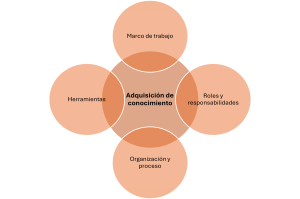Agile & SMEs. The road to success (II)

Introduction
In the previous article we explained how to introduce agility in SMEs. So in this article we will close this series of articles aimed at how to successfully implement Agile in the small business world.
Organisational proposals and training plan
Once the diagnosis has been carried out, different organisational proposals can be defined for the agile management of products and services. It is crucial to design a training plan for employees, teams and management, ensuring that all levels of the organisation understand and understand and commit to agile principles. The choice of a catalogue of tools to facilitate communication and daily work is also an essential component of this phase. is also an essential component of this phase.
The main objectives of this phase are as follows:

Illustration 6. Training objectives in an Agile implementation
- Acquisition of appropriate knowledge for each part of the organisation. This action requires an analysis of the knowledge needs of each of the people and groups involved. of each of the people and groups involved, in order to be able to provide a personalised training itinerary.
- Knowledge about the customised framework for the organisation. The working method, which will be the product of the previous situation analysis, will involve a series of activities and tools which have a specific use, and of which it will be necessary to acquire knowledge and mastery.
- Roles and responsibilities. Agile implementation has a useful impact on the way people organise themselves, communicate and take responsibility for their tasks. As part of the training actions, there will be a space where a new mechanism of coexistence in the organisation can be understood; and how this mechanism benefits the efficiency of the process and the quality of the results.
- Knowledge about the organisation and the process. The framework described above only makes sense if the organisation gains a certain level of experience in managing its demand . organisation gains a certain level of experience in managing its demand, projects, services, dependencies, risks, conflicts, costs, schedules or resources; following an agile management orientation. An agility-oriented team is of little use in an organisation that is not agile.
- Knowledge of tools. Tools are a fundamental part of people ‘ s day-to-day work. Their correct use and, above all, their homogeneous and agile-oriented use, will depend on the success of an agile implementation in SMEs, depends on the success of an agile implementation in SMEs. Therefore , as part of the training actions, will be a special area dedicated to the use of corporate tools corporate tools that are suitable for the new management.
Implementation plan and continuous coaching
Having defined, on the one hand, the current situation of the company; the different organisational proposals aimed at the agile management of products and services; the training plan for people, teams and management; and the selection of the catalogue of tools that will facilitate the day-to-day communications and the work of people in the organisation. With all this, an implementation plan will be established.
This implementation plan will be the product of consensus with the organisation itself, in such a way that the actions that are agreed to be executed are really useful for the company and the people, and are clearly or iented towards the achievement of the intended benefits.
This implementation plan does not merely involve the activation of training tools and actions. It pretends to be something more powerful. Complete coverage and accompaniment throughout the process of implementation and assimilation of knowledge. This includes coaching and support sessions that, together with the company, are deemed necessary. The aim of this accompaniment is to accelerate the assimilation of the meetings, operations and tools established, while ensuring that this new way of working and communicating is carried out in the most efficient, correct and least traumatic way possible.
None of this would make sense if, along with implementation and improvement efforts, there were no mechanisms to measure their achievement, progress and benefits. For all this, the implementation plan should include actions to measure certain variables that will help the implementation team and the company help the implementation team and the company to understand the scope of the actions, their degree of success in implementation, and the necessary adaptations, according to the casuistry of the company.
Do you want to know more about how to implement agile in your company? Do not hesitate to consult our agiletransformation service.
Measuring mechanisms
To ensure the success of the implementation of agile methodologies, it is essential to include mechanisms to measure progress and the benefits obtained. These measurements help to understand the scope of the actions, evaluate the degree of success and make the necessary adaptations according to the specific needs of the company.
Continuoussupport
In a dynamic environment such as that of SMEs, it is vital to have continuous support to ensure the quality and continuity of agile processes. With the support of expert consultants, companies can adapt to new best practices and maintain a constant focus on efficiency a constant focus on improving efficiency, cost control and quality of results.
What are we looking for? Positive impact of agile on SMEs
The adoption of agile methodologies can have a significant impact on the organisation of teams and projects in an SME. Among the most important benefits are:
- Improved value delivery: Agile enables incremental and continuous delivery of value, which means that products and services can be constantly adjusted and improved according to customer and market needs.
- Greater flexibility and adaptability: Agile methodologies facilitate rapid adaptation to changes and new demands, which is essential in a dynamic business environment.
- Teamcohesion and collaboration: The agile approach fosters effective collaboration and communication among team members, which improves cohesion and performance.
- Transparency and visibility: Agile processes provide greater transparency and visibility of projects, This facilitates informed decision-making and efficient management of resources.
- Risk reduction: Continuous delivery and periodic reviews help identify and mitigate risks early, avoiding costly errors and delays.
Conclusion;
The implementation of agile methodologies in SMEs can be a catalyst for organisational transformation and improved value delivery. catalyst for organisational transformation and improved value delivery. Through an agreed implementation plan, coaching sessions and measurement mechanisms, SMEs can achieve greater efficiency, flexibility and adaptability.
At Pasiona, we are committed to accompanying companies on this journey, ensuring that they never feel alone and that they always have the support support to achieve their strategic objectives. In addition, we are experts in the successful implementation of agile methodologies in SMEs.
Agile implementation, Agile Methodology, business efficiency, Digital Transformation, productquality, SMEs, teamcollaboration
Go back


